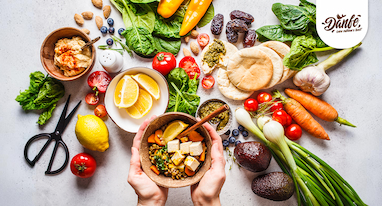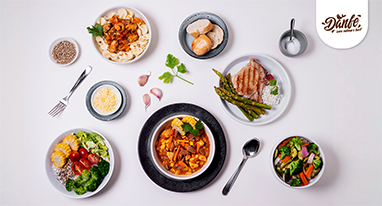A Guide to Using Sesame Seeds
BY DANFE |
Sesame seeds are the seeds of the sesame plant, which is believed to have originated in Asia or East Africa, and ancient Egyptians used the ground seeds as flour. For at least the last 5,000 years, the Chinese have used sesame oil in their cuisine as well as to make ink blocks. These seeds have been used in many cultures for centuries and are largely cultivated around the world. They come in black and white colors and are characterized by a crunchy, nutty, and sweet taste that is very distinctive from other spices. Generally, sesame seeds evoke thoughts of the infamous tahini dip; and play a big role in many Middle Eastern and Asian cuisines.
A variety of delicacies can be prepared using sesame seeds, from traditional sweets and snacks of Asian cuisine to simple toppings in fresh salads. Sesame seeds not only enhance taste, but also provide a number of essential nutrients, such as amino acids, lysine and tryptophan, and a number of other nutrients that are beneficial to our health. They are known to lower the risk of heart disease, promote digestion, and strengthen the bones.
Health Benefits of Sesame Seeds
- Excellent Source of Energy: These seeds are high in polyunsaturated fatty acids, Omega-6 fatty acids, and a range of vitamins and minerals that provide the body with energy.
- Stabilize Blood Pressure: The magnesium in sesame seeds helps prevent hypertension. Sesame oil contains polyunsaturated fats and sesamin, which help to regulate blood pressure.
- Enhance Bone Health: It is generally believed that bone mass decreases after the age of 35. The calcium and zinc in sesame seeds strengthen the bones and also decrease the susceptibility to fracture.
- Boost Immunity: There are various nutrients found in these seeds, such as selenium, copper, zinc, iron, vitamin B6, and vitamin E, which are essential for the production of white blood cells that fight infections.
- Weight Management: Sesame seeds are packed with protein and fiber, which can improve metabolism, regulate the appetite, and prevent excessive calorie intake, thus helping to lose weight.
The nutty flavor of sesame seeds comes out best when toasted or baked and can then be used as a decorative garnish on savory dishes. Chinese cuisine often uses sesame seeds to elevate dishes with a crunchy topping. Many Asian and Middle Eastern dishes contain sesame seeds in salad dressings, soups, and rice dishes. They are extremely versatile and can be used to prepare dishes in a variety of ways. Here are a few sesame seed recipes that demonstrate how to use sesame seeds.
Classic Tahini Dip
This is the ultimate ultra-creamy tahini dip! The best tahini sauce has a creamy texture, nutty aroma, and is irresistible with the flavors of the sesame seeds. It is easy to prepare and can be used in a dip or to prepare other varieties of dishes.
Ingredients
- 4 medium-to-large cloves garlic, pressed or minced
- ¼ cup lemon juice
- ½ cup white sesame seeds
- ½ teaspoon fine sea salt
- Pinch of ground cumin
- 6 tablespoons ice water, more as needed
Instructions
- Combine the garlic and lemon juice in a medium bowl. Give the garlic time to infuse with the lemon juice flavor by letting it rest for 10 minutes. In a separate medium bowl, strain the mixture through a fine-mesh sieve. With a spatula, press the garlic solids to extract as much liquid as possible. Discard the garlic after this step.
- To prepare the tahini, roast the sesame seeds and grind them with some olive oil.
- To a bowl, now add the tahini, salt, and cumin powder. Stir the mixture until it is blended thoroughly.
- Add 2 tablespoons of water at a time, whisking after each addition. After about 6 tablespoons, you will have a smooth, light-colored tahini sauce that is perfectly creamy. If desired, adjust the consistency of the sauce with additional water. If you’d like more tang, add more lemon, or if you’d like more overall flavor, add another pinch of salt. Serve it with some fresh baked pita bread!
Sesame Seed Chutney
The sesame chutney recipe is a popular addition to meaks in Uttarakhand. This dish is usually served with Dal Bhat and Paneer Tikka, but you can pair it with your regular paranthas as well. It is very easy to make and absolutely delicious!
Ingredients
- 1 cup white sesame seeds
- 1 bunch coriander leaves
- 5 garlic cloves
- 3 green chilies
- 3 tbsp lemon juice
- Salt to taste
Instructions
- Dry roast the sesame seeds on a pan at a medium to low flame for 5 minutes.
- Combine the roasted sesame seeds, coriander leaves, garlic, and green chilies in a food processor or blender.
- Grind the mixture, gradually add lemon juice until a fine paste is formed. Serve the chutney with some bread or as a topping for any dish!
Sesame Seed Bowl with Mushrooms
A rice bowl with bok choy, shiitake mushrooms, crispy vegetables, and sesame seeds is all you need for an easy, healthy, and filling lunch. This is one of the best black sesame seed recipes.
Ingredients
- 150g mushrooms
- 3 ½ tbsp soy sauce
- 2 ½ tbsp rice vinegar
- 1 tsp sugar
- 1 tsp sesame oil
- 2 bok choy, sliced in half
- 1 medium carrot, julienned
- ¼ of a small cabbage, shredded
- 50g bean sprouts
- 6 tbsp tahini
- 6 tbsp warm water
- 2 tsp sriracha
- 30g ginger, peeled and minced
- 1 garlic clove, minced
- 3 cups cooked rice
- 1 green onion sliced (optional)
- 1 teaspoon black sesame seeds
Instructions
- Place the mushrooms grill-side up in a dish after removing the stems. Mix 2 tbsp soy sauce, 12 tablespoons rice vinegar, sugar, and sesame oil together in a small bowl. Pour this marinade into the mushroom caps and let it marinate.
- In a nonstick pan, heat the oil over medium heat. Sear the bok choy slices until just browned. Stir in a tablespoon or two of water and cover the pan. Steam the bok choy for a couple of minutes until the stems are tender and bright green.
- Prepare the sauce by combining the remaining 1 ½ tbsp of soy sauce with the rice vinegar, tahini, warm water, ginger, garlic, and sriracha until smooth.
- Toss the mushrooms in the marinade to coat them well, then drain any remaining water from the bok choy. Sear the mushrooms for a few minutes until brown and crispy on both sides. As you fry them, drizzle some of the remaining marinade over them.
- Divide the rice between two bowls and top with the vegetables. Serve with sesame-ginger sauce and garnish it with green onions and sesame seeds!
Til Ki Chikki
A crunchy snack made with sesame seeds and jaggery, perfect for satisfying mid-meal cravings. This delicious winter snack is traditionally made during festivals like Lohri and Makar Sankranti. Because of its long shelf life, the crunchy brittle til chikki can be stored and savored for months. This is one of the best white sesame seeds recipes.
Ingredients
- 200g white sesame seeds
- 500g Jaggery
- 1 cup water
- 1 tsp baking soda
- Greased thali or baking tin
Instructions
- Boil the jaggery until it melts over medium heat. Boil the jaggery syrup on low heat till it gets a glossy and thick consistency.
- Stir in the sesame seeds and cook for another 2 minutes or so, and remove from the heat. Stir in the soda and pour the mixture into your prepared dish. Let it set in thin layers. You can store and have it whenever you want!
As one of the oldest oil-rich seeds, sesame seeds are renowned as the ‘queen of oil seeds’. They are known for their ability to increase energy and even promote healthier skin and hair. These small, nutty-flavored seeds are highly valued by holistic and alternative medicine for their therapeutic properties and their ability to combat health conditions related to metabolic disorders, inflammatory and infectious diseases. Sesame contains antibiotic, anti-inflammatory, and antioxidant properties and these sesame seed recipes are among the best ways to reap these health benefits!




